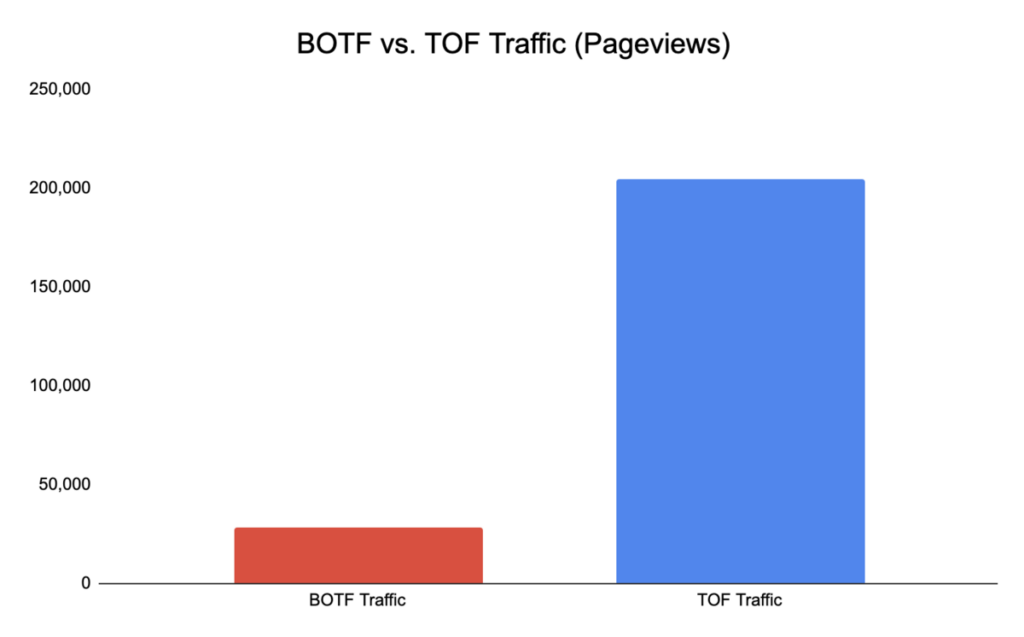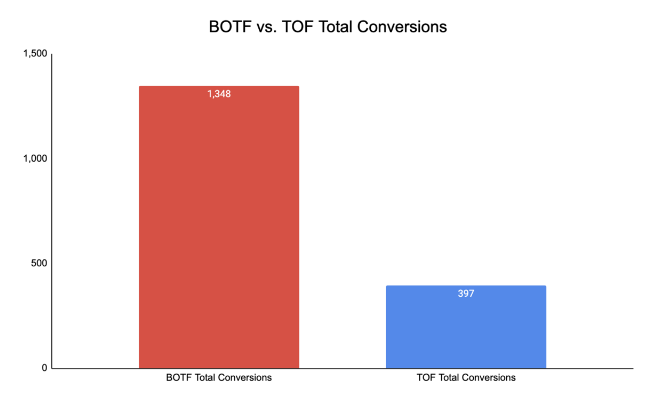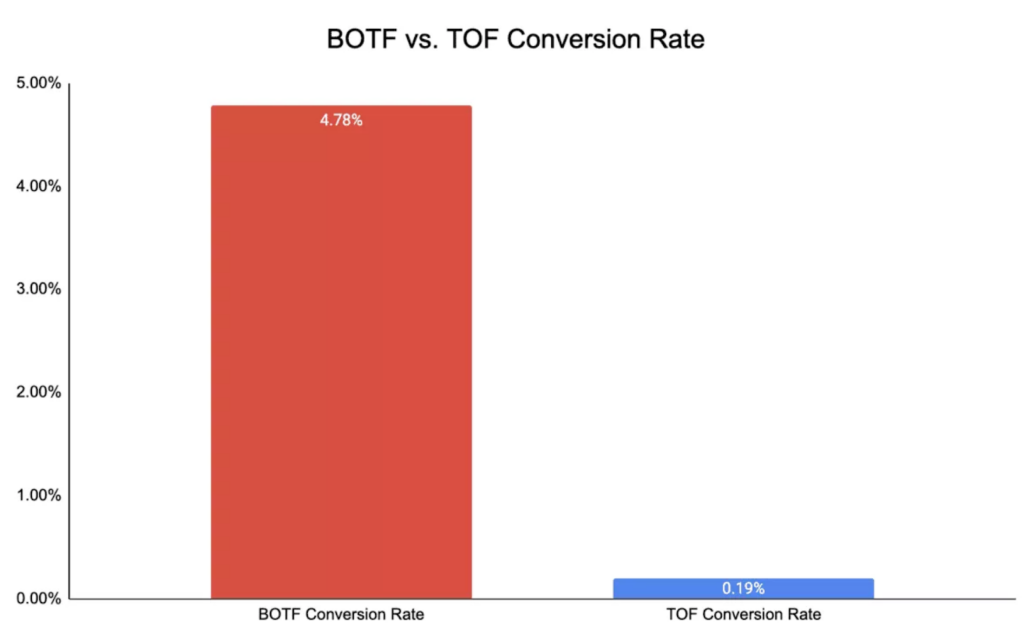A B2B blog strategy clearly defines the who, what, why, and how of your blog:
- Why do you have a blog? Is the intention to drive high-quality leads or traffic? (Despite common misconceptions, driving tons of traffic doesn’t automatically guarantee that any of that traffic will turn into quality leads.)
- What type of strategy will you use: SEO or non-SEO focused?
- Who is your target audience and what interests them?
- How will you produce content: in-house or by outsourcing?
After answering each of these questions in detail, you’ll also need to carefully consider how you implement that strategy.
For example, if you’re focused on leads and SEO, the keywords you choose will make or break the results you end up with. Some keywords drive a lot of traffic but few high quality leads, while others may generate less traffic but the conversion rate will be much higher — 100+% higher. (More on this later.)
In this guide, we’ll cover how to define your blog strategy — including common mistakes that most marketers make and how to avoid/fix them. Then, we’ll also share seven steps for implementing your strategy to ensure you get the best results.
Note: If you’d like help implementing a leads focused B2B SEO strategy, you can learn more about our agency here and reach out about working with us here.
Strategy Decision #1: Choose Whether to Prioritize Traffic or Leads (Hint: You Can’t Do Both)
Most marketers don’t even realize that this is a choice or an option but it absolutely is. And it’s arguably the most important intentional decision you can make in building your blog strategy. You need to be intentional and honest about why you are doing content marketing: do you want traffic and brand awareness, or are you doing it for leads?
In our experience working with countless B2B companies over 6+ years on their blog and content strategy, almost everyone is doing it for leads, traffic is just a means to that end. Sure, if you’re already the brand leader in your space (e.g., Salesforce, QuickBooks) or you just want exposure and mind-share, then a traffic-focused strategy may be the way to go.
But most B2B companies want more leads and they think that first getting high volumes is necessary. This “traffic-first” thinking rests on two main assumptions:
- If thousands of people are visiting our blog, some of those people must convert.
- If we can capture the email of people reading our blog, then we can drip content to them over time and eventually some of them must convert.
In our experience, both of these assumptions are flawed. Here’s why.
Flaw #1: The act of reading something related to your industry doesn’t mean they’re in the market for your product.
Consider the content strategy of a hypothetical HR software company. There is a world of difference in buying intent between someone reading “10 HR trends this year” or a “Guide on HR best practices” and someone searching for “best HR software for small business”. While the former two content titles are on the topic of HR and only interesting to read for HR professionals, they don’t indicate the reader is in the market for HR software. There is no buying intent. Whereas the latter example has tons of buying intent — that searcher and reader is definitely in the market for software like yours. In other words: traffic does not automatically mean conversions.
Flaw #2: You can’t manufacture or force buying-intent with email marketing.
If a prospect reads one of your top of funnel articles and isn’t in the market to buy your HR software, then capturing their email with an ebook or whitepaper and sending them a bunch of emails isn’t going to suddenly make them decide to buy HR software.
As a result of those two truths, if your goal is leads, we suggest focusing on high-buying intent topics rather than traffic. (That’s not to say that you ignore traffic — you simply prioritize lead generation in your blog strategy.)
This conclusion comes from data. Specifically, time and time again we’ve seen high buying-intent content produce higher conversion rates and more leads than TOF content. For example, take a look at the results we got for our client Geekbot, a self-service SaaS company.
In the first screenshot below, you can see that TOF content brought in significantly more traffic than high buying-intent or bottom of the funnel (BOTF) content, as expected.

However, despite that massive advantage in traffic for TOF content, the BOTF content we produced still brought in way more conversions.

The reason for this is that BOTF content has a massively higher conversion rate than TOF content:

This is a result of the buying intent difference we discussed earlier. So, to reiterate, TOF content may bring in tons of traffic but BOTF will bring in more leads. Therefore, you need to be very intentional about whether your end goal is leads or traffic.
Strategy Decision #2: Decide Whether to Do SEO or Non-SEO Content
The next fundamental decision to make is whether you’re going to create SEO or non-SEO content.
With SEO content, you choose a specific keyword that users are searching for and then write the content specifically to rank for that keyword (more on how to do this later).
With non-SEO content, you focus on the blog topics and type of content you want to create (thought leadership pieces, playbooks, etc.) without targeting a specific keyword. The idea is that if your content is interesting enough, it will get viral shares, drive large amounts of traffic, and put your brand on the map.
Here’s a quick look at the pros and cons of each option:
Non-SEO Content
Pros
- You aren’t restricted by keywords or what’s already ranking.
- You can write about any opinionated, helpful, interesting topic that you want and write about it in the way that you want to.
Cons
- To get viral shares and drive huge amounts of traffic, you need to have something original or provocative to say. And, in our experience, very few companies have that. Or if they do, maybe they have one truly original or provocative idea, but not a year’s worth.
- It can be very difficult to get sustained traffic because virality is temporary — at best, if everything goes right, you get a spike in traffic, then it dies down.
SEO Content
Pros
- You get evergreen, compoundable results. Once you rank in the top three positions or even on the first page, the post will continue to generate traffic and conversions month after month. So, each month you can add to your stack of ranking articles instead of chasing new sources of traffic.
Cons
- While it does take longer to see results from SEO, the long-term effects typically more than make up for the short-term costs and you can speed up results with content promotion. (More on this later.)
Strategy Decision #3: Identify the Pain Points of Your Target Audience
If your goal is leads, as it is for most B2B businesses, you’ll need to figure out what struggles drive people to your product/service and what parts of your service convince them to buy (i.e., their pain points). If you can identify these pain points, you can then write content that catches people who are in the exact moment where they’re ready to buy — without having to spend the time or resources to nurture them along.
While you may have some idea of what these pain points are, you’ll get a much better answer and more ideas if you talk to the people who are closest to your audience that also know how your product/service fixes the issues they’re facing — i.e., your sales team and customer success team.
You can ask them questions such as:
- What was the customer/client doing before using our product/service (e.g., using a manual process/working with another competitor)?
- What was the issue with that solution that made them want to switch?
- What parts of our product/service come up the most often on sales calls?
- What questions do the best leads, the ones you know will close, ask? Versus what questions are indicative of tire kickers?
The answers to these questions will dictate the topics you’ll write about and the SEO keywords you’ll target in your blog strategy. If you do nothing else except follow this step, you’ll still see a massive improvement in your blog’s effectiveness versus writing on random TOF topics the way most B2B companies do.
Strategy Decision #4: Decide Who Will Create the Content (In-house vs Outsourced)
We’ve written an entire article on how to decide if you should outsource blog writing or handle it in-house. However, one important takeaway is that if you choose an SEO strategy, you’ll need a team to tackle jobs like keyword research, content writing, technical SEO, analytics, and web development. It’s unrealistic to expect that one or even two marketers can handle all of this on their own (especially if you expect to generate large volumes of content).
We’ve also written an entire article on the flaws with how most companies (and even many SEO agencies) outsource content writing. The main takeaway is that most companies ask writers to a) research a topic and write a post, or b) write a post based off of a content brief.
The main issue with these two approaches is that you’re putting the responsibility to come up with detailed arguments and supportive evidence on the writer. Since they aren’t subject matter experts, they won’t be able to do that effectively. Some companies try to solve this by having the writers interview third-party experts. However, the post then reflects the opinions of that expert rather than the opinions and views of your company.
The best way to generate smart, unique posts that reflect your company’s voice is to have the writer interview subject matter experts within your company.
7 Tactical Steps for Implementing Your B2B Blog Strategy
Step 1: Decide How Often to Publish (Tip: Prioritize Quality Over Quantity)
In our opinion, your main goal should be to produce quality content because that’s what ranks, attracts the highest quality leads, and gets conversions. A single SEO ranking for your absolute best, highest buying intent keyword is worth 500 random top of funnel posts. However, many B2B marketing teams also get pressure from leadership to produce a high volume of blog content.
Ultimately this balance is up to you, but in our experience, a perfectly fine option to balance both quality and quantity is to publish one new post per week (we’ve also seen good results from only publishing one or two new posts per month). For most companies, this is a perfectly fine volume. If the powers that be want more, you can slowly start to add more articles per month to your content calendar as long as you don’t compromise quality. This approach lets you work towards producing larger amounts of content while still ensuring that content will be effective.
Step 2: Choose Your Topic
For SEO and lead-focused content, your goal should be to find relevant keywords with high-buying intent (i.e., keywords that show the googler is looking to buy a product like yours right now). We’ve written multiple articles around this topic. Here are a few to get you started:
- How to Find & Rank for Bottom of the Funnel Keywords
- How to Find and Use Secondary Keywords to Increase Conversions: A Case Study
- How to Research Competitor Keywords (And Find Hidden Gems)
- SaaS Keyword Research: Choosing Keywords That Drive Leads
- How to Use Jobs-to-Be-Done (JTBD) Keywords in Your SEO Content Strategy
Finding non-SEO content ideas is often more difficult because you have to find something unique and shareable to write about. However, we still recommend starting with your potential customer’s pain points and brainstorming ideas around those. Here are some ideas:
- Write your company’s disruption story. (This is essentially the story of why you decided to create your company.)
- Pull together unique, interesting data and analyze it.
- Craft case studies that highlight how your company solves a specific problem.
- Share details about projects that you’ve worked on (or are working on currently).
- Discuss your company’s opinions about various aspects of your field.
Step 3: Decide Whether to Produce New Content or Optimize Existing Content
In our experience, nine times out of ten, you’ll need to produce an entirely new piece of content to rank for the specific keywords you’re targeting. (You’ll always need to create new content for non-SEO topics.)
However, sometimes there will be two keywords that seem nearly identical, which leads many marketers to wonder if it’s actually worth creating a separate post for each keyword or if they should lump multiple keywords into one post. The answer depends largely on how closely related the Google search engine results pages (SERPs) are. For this step, you can simply scan the titles of the top ten results — you don’t need to read each article.
If the results are nearly identical for both keywords, you can likely optimize one blog post for both keywords. However, if the SERPs are considerably different, you’ll need different posts. If there is some overlap, say three to five of the first page results, you’ll need to make your best guess and test it.
Step 4: Research and Outline
For SEO blog posts, this step is where you’ll carefully read through each of the top ten results on Google. You’ll also want to scan through the “People also ask” and “Related searches” sections. The idea here is to figure out:
- What the top 10 results all have in common that you’ll also need to include to rank.
- How you’ll make your post unique or more helpful to the reader in some way.
If you make note of these things as you look through the SERP, you’ll have a pretty good idea of what needs to be included in your post. Then, you can arrange the information in a logical, helpful way and fill in the outline with any missing gaps such as examples to back up your arguments, background information, etc.
For non-SEO content, you’ll follow a similar process of figuring out what everyone else is saying and then decide what originality nuggets you have to offer (i.e., how your post will be unique). With non-SEO content, you’ll also need to cast a wider net and look beyond Google results at whatever platform(s) you intend to promote it on (e.g., LinkedIn, Twitter, industry-specific forums).
Step 5: Create Content
If you’ve done the SERP analysis and outlining from the previous step well, then all of the arguments and structure of the piece should be decided so writing should be relatively straightforward. In terms of the actual writing, we’ve written extensively about content creation in other posts, which you can check out here:
- The Detail Principle for Writing Good Blog Posts
- How to Write Great Blog Introductions (+ Why Most Are Bad)
- SEO Content Writing: A 5-Step Process You Can Follow
- Content Creation Process: How to Produce Unique Content
You’ll also want to add a call-to-action (CTA), meta description, and any helpful visuals at this stage.
Step 6: Publish and Promote
This step is essential for non-SEO posts since it’s unlikely you’ll get organic traffic. However, it’s also helpful for SEO. It can take up to a year before you see results from SEO, but content promotion can help drive short-term results and speed up the SEO process.
When it comes to content promotion, there are three main options: social media, paid search, and link building (both external and internal links).
Creating posts and threads on social media (e.g., Twitter, Facebook, LinkedIn) can drive traffic immediately after a blog post has been published. However, it can be difficult to maintain results with this strategy because organic social traffic is spikey — you get some website traffic if a post hits a chord with the audience, but it dies down quickly. Plus, getting that traction in the first place can be a challenge: algorithms change, it’s difficult to scale, and there’s already so much content promotion happening on social media that it can be hard to stand out. (We talk more about this topic here.)
That’s why we focus on paid search and link building as part of our SEO services. Both of these strategies are easily scalable and a great way to drive more immediate results.
Step 7: Track Results
Whether your goal is leads or traffic, you need a reliable, quantifiable way to track results. You can use GA4, HubSpot, or a tool such as WhatConverts to track leads. For SEO content, you’ll also need to track rankings with a tool such as Ahrefs or Semrush.
In terms of ROI, here are a couple of articles to get you started and give you an idea of what to expect:
- Content Marketing Attribution: How to Measure Content Performance
- Most Companies Measure Content Marketing ROI Incorrectly. Here’s Why (and How to Fix It).
- How Long Does It Take to Rank on the First Page of Google?
Learn More About Our SEO and Content Marketing Agency
- Our Agency: If you want to hire us to execute a content marketing strategy built around driving lead generation and sales, not just traffic, you can learn more about our service and pricing here. We also offer a PPC service for paid search, which you can learn about here.
- Join Our Content Team: If you’re a content marketer or writer and would love to do content marketing in this way, we’d love to have you apply to join our team.
- Our Content Marketing Course: Individuals looking to learn our agency’s B2B content marketing strategy and become better marketers, consultants, or business owners can join our private course and community, taught via case studies, and presented in both written and video content formats. We include several details and examples not found on this blog. Our course is also built into a community, so people ask questions, start discussions, and share their work in the lesson pages themselves, and we, along with other members, give feedback. Learn more here.








